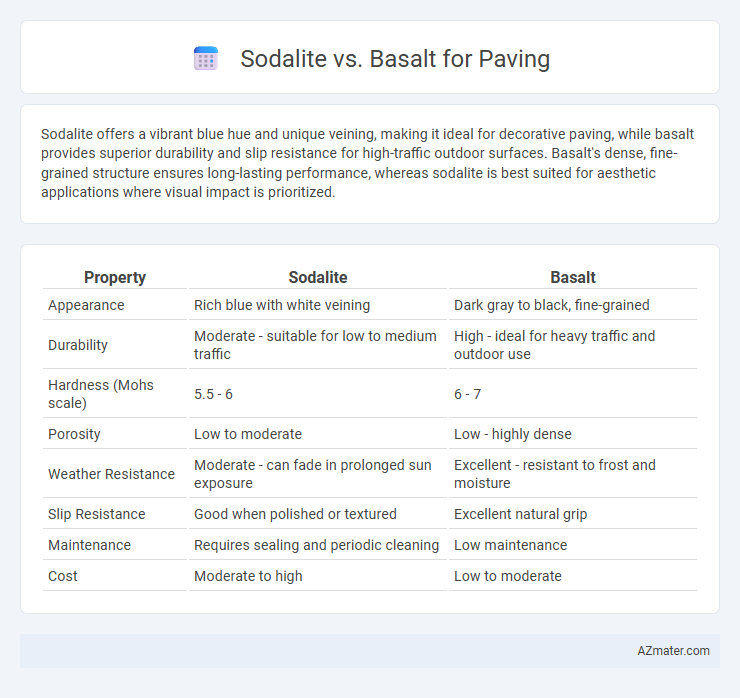Sodalite offers a vibrant blue hue and unique veining, making it ideal for decorative paving, while basalt provides superior durability and slip resistance for high-traffic outdoor surfaces. Basalt's dense, fine-grained structure ensures long-lasting performance, whereas sodalite is best suited for aesthetic applications where visual impact is prioritized.
Table of Comparison
| Property | Sodalite | Basalt |
|---|---|---|
| Appearance | Rich blue with white veining | Dark gray to black, fine-grained |
| Durability | Moderate - suitable for low to medium traffic | High - ideal for heavy traffic and outdoor use |
| Hardness (Mohs scale) | 5.5 - 6 | 6 - 7 |
| Porosity | Low to moderate | Low - highly dense |
| Weather Resistance | Moderate - can fade in prolonged sun exposure | Excellent - resistant to frost and moisture |
| Slip Resistance | Good when polished or textured | Excellent natural grip |
| Maintenance | Requires sealing and periodic cleaning | Low maintenance |
| Cost | Moderate to high | Low to moderate |
Introduction to Sodalite and Basalt Paving
Sodalite and basalt are popular materials for paving due to their durability and unique aesthetics. Sodalite, a deep blue mineral with white veining, offers a striking appearance and moderate hardness suitable for decorative paving. Basalt, a dense volcanic rock, provides superior strength and weather resistance, making it ideal for heavy-traffic and outdoor paving applications.
Geological Origins and Formation
Sodalite originates from igneous rocks rich in sodium and aluminum, typically forming in nepheline syenite and related alkaline igneous complexes, characterized by its deep blue color with white veining. Basalt is a dense, fine-grained volcanic rock formed from the rapid cooling of basaltic lava at the Earth's surface, abundant in iron and magnesium minerals. The contrasting geological origins impart sodalite with a more ornamental appearance suitable for decorative paving, while basalt's volcanic origin provides exceptional strength and durability ideal for heavy-traffic paving applications.
Physical Properties Comparison
Sodalite exhibits a Mohs hardness of around 5.5 to 6, making it relatively softer compared to Basalt, which ranks 6 to 7 and offers superior durability for paving applications. Basalt's higher density and low porosity enhance its resistance to abrasion, weathering, and chemical attack, while Sodalite's lighter weight and moderate porosity can result in increased wear over time. Thermal conductivity differences also favor Basalt, as its ability to endure temperature fluctuations minimizes cracking and prolongs pavement lifespan.
Aesthetic Appeal and Color Variations
Sodalite offers a striking aesthetic appeal with its rich blue hues and white veining, creating a visually dynamic surface ideal for decorative paving projects. Basalt, known for its dark gray to black color spectrum and uniform texture, provides a sleek, modern look that complements minimalist and industrial design styles. The color variations in sodalite are more vibrant and distinct, while basalt's subtle tonal differences contribute to a consistent and sophisticated paving appearance.
Durability and Hardness
Sodalite and basalt differ significantly in durability and hardness when used for paving. Basalt, a dense volcanic rock with a Mohs hardness of 6-7, offers superior resistance to wear and impact, making it ideal for high-traffic areas. Sodalite, with a lower hardness of around 5.5, is less durable and more prone to chipping and weathering under heavy use.
Slip Resistance and Safety
Sodalite offers moderate slip resistance suitable for residential paving but generally lacks the textured surface needed for high-traffic safety zones compared to basalt. Basalt's naturally rough texture significantly enhances grip, making it ideal for commercial or public spaces where slip resistance is critical. Selecting basalt over sodalite improves overall pedestrian safety by reducing slip hazards in wet or oily conditions.
Cost and Availability
Sodalite, known for its vibrant blue hues, is less common and typically more expensive than basalt, which is widely available and cost-effective for paving projects. Basalt's abundance and durability make it a preferred choice for large-scale paving due to lower material and maintenance costs. Sodalite's rarity and price can increase overall project expenses, limiting its use to decorative or high-end applications.
Installation Process and Maintenance
Sodalite offers easier cutting and shaping during the installation process due to its softer texture compared to basalt, which requires specialized tools for precise handling. Basalt's dense and durable composition demands more labor-intensive installation but provides superior resistance to wear and weathering. In terms of maintenance, sodalite may need more frequent sealing to protect against staining and erosion, while basalt's natural resilience results in lower long-term upkeep and enhanced durability for high-traffic paving areas.
Environmental Impact and Sustainability
Sodalite, a rare and vibrant blue stone, has a higher extraction impact due to its limited availability and specialized quarrying methods, making it less sustainable for large-scale paving projects compared to basalt. Basalt, an abundant volcanic rock, is widely used for paving due to its durability and lower environmental footprint from extensive local quarrying and recycling potential. The sustainability of basalt paving is enhanced by its longevity, minimal maintenance, and lower carbon emissions throughout its lifecycle.
Best Applications: Sodalite vs Basalt for Paving
Sodalite's vibrant blue hues and moderate durability make it ideal for decorative paving in residential patios and garden pathways where aesthetic appeal is prioritized. Basalt offers superior hardness and resistance to wear, making it the preferred choice for high-traffic commercial pavements, driveways, and industrial flooring. Both stones provide excellent slip resistance, but basalt's heat resistance and longevity give it an advantage in outdoor urban environments demanding robust performance.

Infographic: Sodalite vs Basalt for Paving
 azmater.com
azmater.com